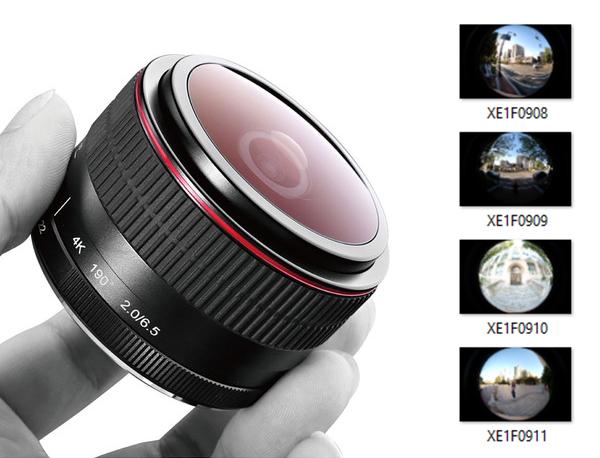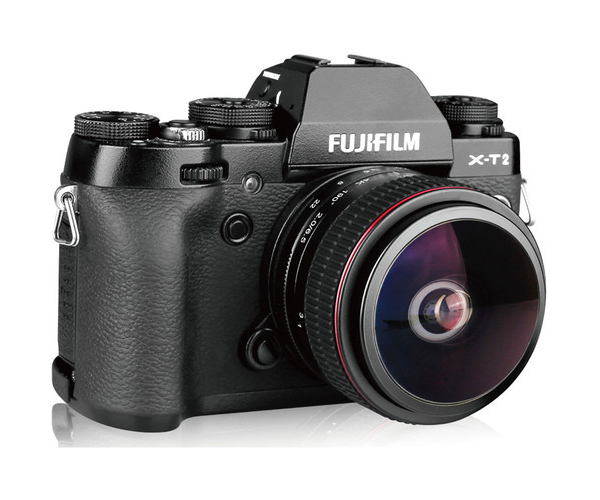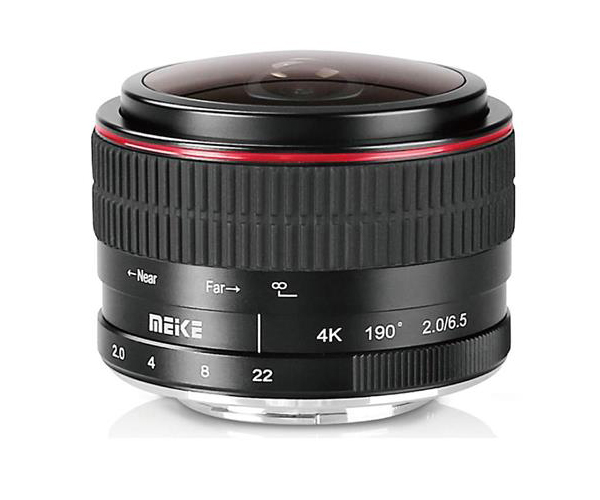Meike MK 6.5mm f/2 Circular Fisheye Lens Review

This lens has me going in circles. I spent weeks looking for a well-rounded person to photograph. Every image I captured was pointless. Okay—enough of the circle jokes. Time to get a round to the review.
A couple weeks ago we published 10 Tips for Shooting with a Circular Fisheye Lens. Every image in that story was shot with the Meike MK 6.5mm f/2 Circular Fisheye on a Fujifilm X-E1. Here’s our review of that lens.
 Tech Description
Tech Description
Somewhere in a parallel universe, a fish is using a Humaneye Lens and wondering if people really see such a narrow angle of view. No matter. Here in our perceptual kingdom we call lenses that can take in 180° or more fisheye.

Can you recall what you learned about vanishing points in seventh grade art class? In a nutshell, two-dimensional perspective projections of parallel lines in three-dimensional space appear to converge. Well, put on a fisheye lens and throw that out. Oh, parallel line do still converge, but they take a dipsy doodle path.
The Meike lens is marked 190°. I can neither confirm nor dispute that scientifically, and I can’t make contact with anyone at Meike. So we’ll leave it there. The lens is also marked 4K and I’m not going to guess what they mean to impart with that label.

Must be a box-turtle-eye lens, no? No. Not all fisheye lenses produce circular images. Depending on the camera-plus-lens combination, the result is either a circular image in the center of the frame or a curvy, warped image the completely fills the frame. Understanding how and why this dichotomy exists helps us understand how lenses work in general.
Being round, lenses transmit a circle of light that is large enough to completely circumscribe the imaging sensor. Some fisheye lenses do the same, but some transmit a circle of light that is inscribed inside the imaging sensor. The latter flavor is called circular.
Some fisheyes can’t quite cover an imaging sensor fully, but the shaft of light they throw is too big to fit completely within the confines of the sensor’s rectangular shape. The result is unpleasant and can include some unsightly black borders. The takeaway is that if you want to create circular fisheye images, make sure the lens you choose performs as expected on your particular camera model.

Available in mounts for Fujifilm X, Micro Four Thirds, Canon EOS-M and Sony E-mount, the Meike MK 6.5mm f/2 Circular Fisheye creates a full circle when used on a Fujifilm camera. I did not test other camera mounts, but I am speculating that they work the same way.
Stretching the tape at 2.4 x 2.0 inches (61 x 51.5 mm) and weighing in at 10.6 oz (300g) the Meike fisheye rides easily in your gadget bag or coat pocket until you’re in the mood to bend some perpendicular lines. And bend them it will.
Build Quality
The Meike MK 6.5mm f/2 Circular Fisheye lens is surprising well made, better than one might expect at such a low price point. The barrel turns smoothly and the aperture ring, which does not have click-stop detents, offers a slight resistance, a welcomed feature which I assume is intentional. The knurled rubber ring that covers the lens barrel is comfortable and grippy, and the lens cap is constructed of metal and fits snuggly. All markings are clear and easy to read, and while I did not check the focusing distance scale for accuracy, it really doesn’t matter with a lens of this type because of the expansive depth of field.

The lens mount is metal and it appears that the rear of the lens is sturdy and properly coated with antireflection material. Overall, from front to back, this lens is well made.
A word of caution for this and every lens of similar design: the front element extends slightly beyond the barrel. That’s not intrinsically bad, but it makes the lens vulnerable to front impact. This is not a knock against the Meike lens; if you want 190° coverage, you’ve got to hang out a bit over the front edges. Just be careful to not smash it into the subject.

Features
Manual focus and manual exposure, the Meike fisheye cannot communicate with the camera body so the photographer has to do all of the work. No problem—set the camera on Aperture priority and select a medium f/stop, for instance f/5.6. Set the focus ring to 3 feet and presto! The depth of field encompasses all subjects from (about) two feet away to infinity.
You can also perform manual focusing deliberately, using the EVF or LCD monitor, but the subjects appear quite small and unless you have exceptional vision, it’s a challenge. Besides, mil-spec accuracy is not necessary.
In the field I used Manual exposure primarily, opting for Aperture Priority only when hurried. Fisheye lenses have an extreme field of view and it’s easy (meaning common) for any camera’s built-in metering system to be fooled. After focusing I set the shutter speed and looked at the LCD monitor while stopping down the lens. Judging “by eye” isn’t always easy or accurate, but it served me well, and overall I was more satisfied using this method.
The optical design deploys 6 elements in 5 groups. The aperture range extends from f/2 to f/22 but only every other f/stop is marked. So to set f/5.6 you must know that it resides midway between f/4 and f/8. The Meike fisheye does not accept filters (the filter ring would appear in the picture) and cannot accommodate a lens shade.

The lens coating appears to be multilayer. I shot a few images that included the sun directly and to my amazement there was miniscule flare. This is unusual for any lens, and especially uncommon for a super-wide-angle or fisheye. I did not disassemble this lens but I can predict that there’s some mighty fine baffling and flare suppression happening inside.
Performance
Amazing. Simply amazing. Once you get over how unique and exciting a fisheye image looks you realize that this lens is damn sharp. There’s some edge softness, but who can tell, really, because the perspective is entirely warped, parallel lines are bent and everything except what’s in the center is wonderfully distorted. This isn’t sarcasm; this is precisely what a fisheye lens is designed to do.

Carefully align the horizon when you use this lens. Tilting upward causes the horizon to bow downward and vice versa. Start with the camera parallel to the ground, horizon flat, and tilt creatively up and down from there. My Fujifilm X-E1 can display an electronic horizon indicator on the LCD. It’s a feature I very rarely use, but it comes in handy when using this glass.©Jon Sienkiewicz
BTW, don’t bother trying to shoot a vertical (portrait orientation) image. The picture is round so it doesn’t matter. I bring this up because I tried it out of habit before I realized the folly. However, it does matter if you rotate the camera around the lens axis. Try it.
Conclusion
Unless you have a rectangle fetish, acute aversion to circles, or rigidly dislike having fun with your camera, buy this lens. Price is $129 from Amazon but I found a coupon and got mine for $119. It’s one of the least expensive accessory lenses you can buy and it’s very well made. You may not use it every day, but I’m willing to bet that you will use it a lot.

After a few days with this (or any) fisheye you begin to recognize subjects that are perfect for fisheye capture. It can certainly jumpstart your creative engine. And there are some very creative things you can do during post-processing. In case you missed the link at the top of this story, click here to read the 10 Tips for Shooting with a Circular Fisheye Lens how-to piece that we published a short time back.
Price: You can buy the Meike MK 6.5mm f/2 Circular Fisheye for $130-$150 for Fujifilm X, Micro Four Thirds, Canon EOS-M and Sony E-mounts
—Jon Sienkiewicz
- Log in or register to post comments

















































